 Image search results - "Hogonji" Image search results - "Hogonji" |
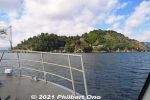
Approaching Chikubushima, Lake Biwa's most famous, historic, and sacred island. Takes about 30 min. from Nagahama Port. I've visited this island a number of times before, but this time I wanted to see something I'd never seen before.
|
|
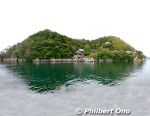
Chikubushima on Lake Biwa is home to Hogonji Temple first built in 724 as ordered by the Emperor to worship the Goddess Benzaiten. It belongs to the Shingon Buddhist Sect (Buzan School) and it is the 30th temple in the 33-Temple Pilgrimage of Saigoku.
|
|
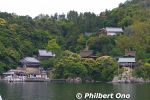
Chikubushima (竹生島) is a small, sacred island dominated by a temple/shrine complex called Hogonji (宝厳寺) perched on this fairly steep slope. The temple/shrine's construction was ordered by the emperor in 724 when he proclaimed that Chikubushima was a sacred place for the goddess Benzaiten (弁才天). The temple was to bring national peace, bountiful harvests, and prosperity to all. A priest named Gyoki (僧行基) then proceeded to build the temple with Benzaiten as the principal object of worship.
|
|
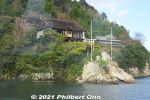
All human presence is on this south side of the island. There are no roads and no cars. There is no path to walk around the island's perimeter nor to any other side of the island. Everything is within walking distance, but there are some steps to cli(No elevators or escalators.)
|
|
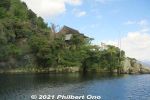
Chikubushima is also home to Tsukubusuma (Chikubushima) Shrine which is also a National Treasure. Until 1868 when Buddhist temples and Shinto shrines were required to be separate, the shrine was part of Hogonji temple.
|
|
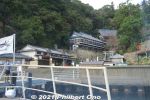
Most people spend 80 min. or 90 min. on the island before taking the return boat. Be sure to remember the departure time of your return boat especially if it's the last one for the day. (No lodging on the island.)
|
|
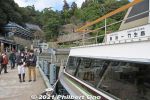
Chikubushima boat dock.
|
|
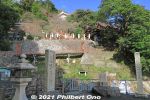
After you get off the boat at Chikubushima, you face this slope of buildings. Many monuments. On the upper right is the famous Karamon Gate.
|
|

Karamon Gate (National Treasure). A closer look is shown below.
|
|
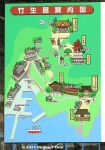
Map of Hogonji Temple. All within walking distance. Not wheelchair accessible. 1. Chikubushima: Boat dock, 2. Lake Biwa Rowing Song monument, 3. Souvenir shops, 4. Admission ticket gate (also restrooms), 5. *Tsukubusuma Shrine, 6. Haiden Hall,7. Funa-roka boat corridor, 8. *Karamon Gate, 9. Benzaiten-do Hall, 10. Three-Story Pagoda, 11. Rest house. *National Treasure.
A few buildings are for temple priests only.
|
|

Take your trash with you.
|
|
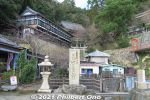
Many monuments on Chikubushima. The large building on the upper left is the quarters (本坊) for temple priests.
|
|
|
|

Suggested tour route.
|
|
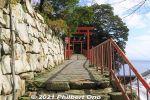
After some steps, a small torii to Tsukubusuma Shrine.
|
|
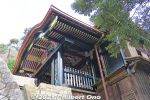
Karamon Gate (National Treasure)
|
|
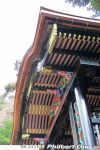
Karamon Gate roof eaves.
|
|
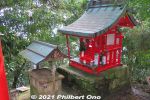
黒龍堂
|
|
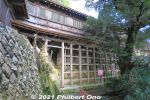
Exterior of Funa-roka boat corridor connecting Tsukubusuma Shrine and the Kannon-do Hall. Important Cultural Property. From the Momoyama Period. 船廊下
|
|
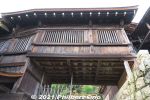
Exterior of Funa-roka boat corridor.
|
|
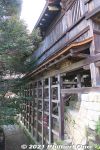
Exterior of Funa-roka boat corridor on stilts.
|
|

Inside the Haiden Hall, you can buy these little dishes. Buy two of them. You write your name on one and your wish on the other dish. Then throw it through the torii gate.
|
|

Funa-roka boat corridor goes to Kannon-do Hall. 船廊下
|
|

Kannondo Temple has been beautifully renovated with its many intricate wood carvings and paintings on walls, doors, and ceilings restored in March 2020. 観音堂
|
|
|
|
|
|
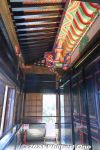
Corridor facing the Funa-roka.
|
|
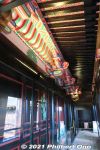
Corridor facing the Funa-roka.
|
|
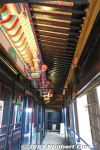
Corridor facing the Funa-roka.
|
|
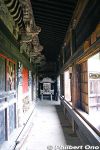
Corridor facing the Funa-roka before the restoration. Everything was drab looking. After the restoration, the windows on the right are now kept closed.
|
|
|
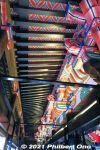
Decorative wooden support assemblages called tokyo (枓栱) or dougong. They are now illuminated to show off the vibrant colors.
|
|
|
|
|

Corridor and incense burner in front of the altar. The wooden pillars totally re-lacquered.
|
|
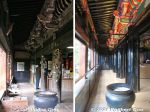
Before-and-after photos of the corridor in front of the altar. The wooden pillars that used to be covered with pilgrim name stickers are now all gone. Pillars totally re-lacquered. 観音堂
|
|
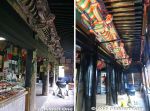
Before-and-after photos of the corridor in front of the altar. The wooden pillars that used to be covered with pilgrim name stickers are now all gone. Pillars totally re-lacquered. 観音堂
|
|
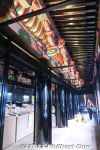
Above the pillars are decorative wooden support assemblages called tokyo (枓栱) or dougong. They have also been brilliantly repainted and even lit up. Dougong are interlocking wood pieces commonly found on temples and shrines as a Chinese influence.
|
|
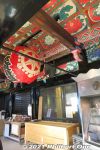
In front of the main altar of Kannon-do. The hall worships a thousand-arm Kannon statue (hidden from the public).
|
|
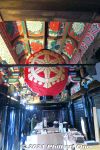
Ceiling in front of the altar includes a red paper lantern.
|
|
|
|
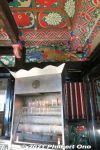
Candle holder.
|
|
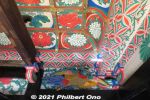
Kannon-do ceiling and transom carvings.
|
|
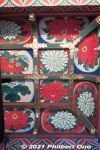
Ceiling paintings of flowers.
|
|
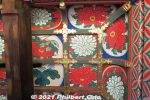
Kannon-do ceiling of painted flowers. Peonies (red), chrysanthemum (white), and paulownia (blue). 牡丹、菊、桐
|
|
|
|
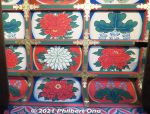
Kannon-do ceiling of painted flowers. Peonies (red), chrysanthemum (white), and paulownia (blue). 牡丹、菊、桐
|
|
|
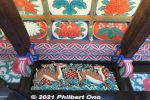
Kannon-do ceiling and transom deer carvings.
|
|
|
|
|
|
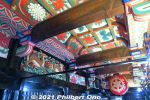
Kannon-do ceiling and transom carvings. Absolutely brilliant colors.
|
|
|
|
|

Corridor in front of the altar.
|
|
|
|
|
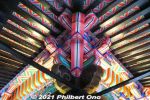
Kannon-do Hall roof corner with a tokyo assemblage. So much eye candy in this building.
|
|
|
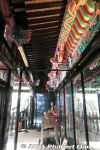
Heading toward the statue of Pindola Bharadvaja. The carved walls are now protected with plexiglass.
|
|

Before photo of the statue of Pindola Bharadvaja and the nearby wall with flower carvings.
|
|
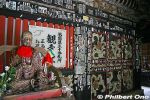
Before photo of the statue of Pindola Bharadvaja and the nearby wall with flower carvings. (See the next photo after the restoration.)
|
|
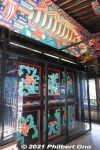
After photo of the restored wall flowers near the statue of Pindola Bharadvaja.
|
|
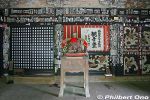
Before photo of a very old and worn statue of Pindola Bharadvaja (賓頭盧尊者). Traditionally, you touch his body part corresponding to the part of your body you want to heal. Notice the pillars and ceiling beams which were plastered with pilgrim name stickers called "senjafuda" (千社札). They bear the ardent pilgrim's name and pilgrims stuck their name stickers on the temples they visited to indicate "I wuz here!"
|
|
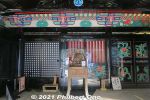
After photo of Pindola Bharadvaja statue. These days, best not to touch unless you use hand sanitizer afterward.All those old pilgrim name stickers (mostly from the Edo Period when it was fad) were removed for a new layer of lacquer.
|
|
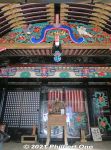
Pindola Bharadvaja statue right inside Karamon Gate.
|
|
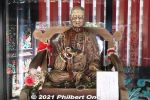
Worn statue of Pindola Bharadvaja (賓頭盧尊者).
|
|
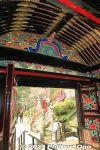
Inside Karamon Gate. Just gorgeous. Too bad most people just walk in without looking back and noticing.
|
|
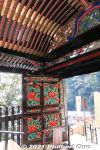
Karamon Gate door.
|
|
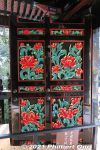
Karamon Gate door.
|
|
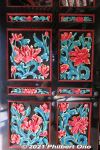
Karamon Gate door.
|
|
|
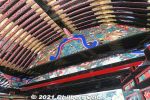
Behind the Karamon Gate.
|
|
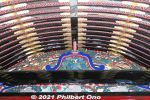
Behind the Karamon Gate.
|
|
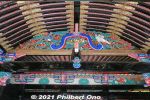
Front of Karamon Gate.
|
|
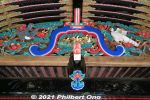
Nest of birds in this decorative, hump-shaped wood support called "kaeru-mata" (蟇股). Commonly found on entrances of important buildings. In Nikko, Toshogu Shrine's famous "Sleeping Cat" carving is also a kaeru-mata.
|
|
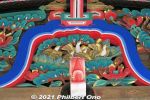
Closeup of the "kaeru-mata" showing a nest of birds. (蟇股).
|
|
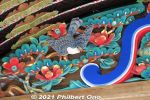
Left side of the kaeru-mata.
|
|
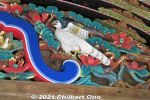
Right side of the kaeru-mata.
|
|
|
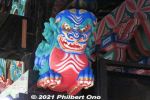
One of the lion dogs on Karamon Gate. Brought back to life from a drab-looking brown. It's part of a wooden protrusion called the "kibana" (木鼻).
|
|
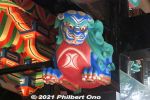
One of the lion dogs on Karamon Gate. It's part of a wooden protrusion called the "kibana" (木鼻).
|
|
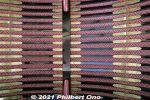
Ceiling inside Karamon Gate, looking directly upward.
|
|

Karamon Gate 唐門 (National Treasure) before it was restored in March 2020. See the next photo.
|
|
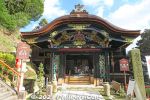
Karamon Gate 唐門 (National Treasure) beautifully restored to its original splendor. Entrance to the Kannondo Temple.This gate is said to have come from Toyotomi Hideyoshi's Gokuraku Bridge at Osaka Castle in the early 17th century (Momoyama Period). Chikubushima, Nagahama, Shiga.
|
|
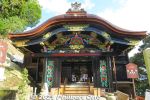
Karamon Gate looks new, but it's actually over 400 years old. "Karamon" (唐門) is a generic term for Chinese-style gates.There are other Karamon Gates in Japan, namely the more elaborate one at Nishi Hongwanji Temple in Kyoto. Karamon have colorful and intricate wood carvings and decorative features.
|
|
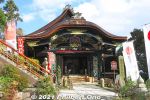
It looks new because it was magnificently restored (including the roof) after six years of meticulous work completed in March 2020. Finally came to see it. I was not disappointed. It's jaw-dropping beautiful.
|
|
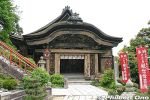
Karamon Gate before the restoration. Very drab-looking with most of the paint and lacquer weathered away by the elements after 67 years when it was last repainted.
|
|
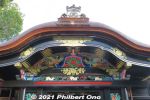
It's the entrance of the temple's Kannon-do Hall that worships Kannon. The gate features the karahafu roof gable shaped like a hump, commonly found on important traditional buildings such as temples and castles.
|
|
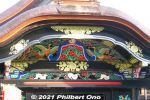
The roof was also entirely restored. The gate is a splendid example of the finest art from the Momoyama Period (late 16th century).
|
|

Before photo. Without the colors, it was so hard to see the wood carvings.
|
|
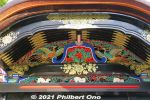
Some of the wood carvings had pieces that broke off or worn out. So they were reconstructed too. The metal fittings were also re-plated or remade.
|
|
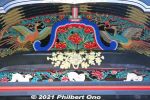
Never noticed those white rabbits before...
|
|
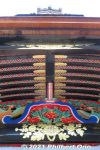
It's really pleasing to see this and other major National Treasures being restored during the past 10 years. There's also Nikko Toshogu Shrine in Tochigi and Menuma Shodenzan Temple in Saitama which have been refreshed with vibrant colors and laWith modern technologies, computers, laser measurements, and scientific techniques, restoration specialists can more accurately assess and reproduce the original colors and pigments. But much of the work is done by hand.
|
|
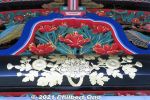
The only damper on this stupendous work is that, the contractor who did the job and the local government employee in charge of the project were found to have colluded to rig the bidding process. The project's budget was leaked to the contractor before the bidding started. Both parties were arrested a few months after the job was completed. At least the police waited until the job was done before arresting them.
|
|
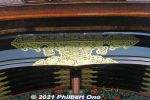
Center metal fitting on the Karamon.
|
|
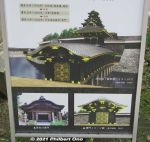
Karamon Gate was originally built in 1596 as the gate for a covered wooden bridge named Gokuraku-bashi (極楽橋) at Osaka Castle as depicted here.
|
|
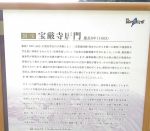
The gate and other castle structures were later moved to warlord Toyotomi Hideyoshi's mausoleum in Kyoto in 1600. In 1603, Hideyoshi's son ordered Karamon Gate to be moved to Chikubushima to help rebuild Hogonji Temple which was in disrepair at Chikubushima had close ties to Toyotomi Hideyoshi since he was once the lord of Nagahama Castle. Chikubushima was part of his domain.
|
|
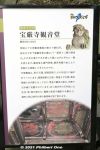
About the Kannon-do Hall.
|
|
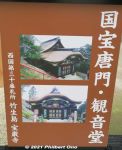
What the Karamon looks like with the doors closed.
|
|
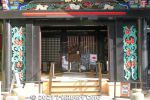
Karamon Gate entrance to Kannon-do Hall.
|
|
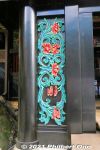
Left door of Karamon Gate.
|
|
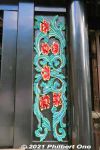
Right door of Karamon Gate.
|
|
|
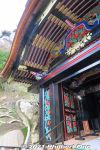
Left side of Karamon Gate. The gate doors are also adorned with peony flower carvings.
|
|
|
|
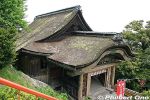
Before the renovation, Kannon-do and Karamon Gate had this old, moldy roof.
|
|
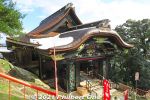
The roof was also rethatched with new cypress bark. The last time the building was reroofed was in 1972. (The white patch is snow.)
|
|
|
|
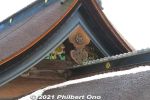
A pair of tigers on the main roof.
|
|
|
|
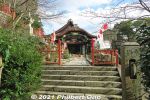
Path to Karamon Gate.
|
|
|

Steps between the Karamon Gate and Benzaiten-do.
|
|

Benzaiten-do Hall, Hogonji's Hondo main worship hall. Hogonji Temple belongs to the Shingon Buddhist Sect (Buzan School). Benzaiten is the goddess of everything that flows: Water, rivers, music, etc. 弁才天堂
|
|
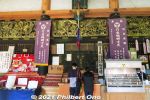
Inside Benzaiten-do Hall. Many famous samurai, such as Oda Nobunaga and the Azai Clan, worshipped at Chikubushima since they believed Benzaiten had the power to destroy their enemies.
|
|
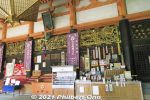
Inside Benzaiten-do Hall which houses one of Japan's three major statues of the Goddess Benzaiten.
|
|
|
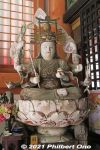
Inside Benzai Tendo. The statue of Benzaiten in the corner was donated by the father of Lord Azai Nagamasa. The Nagamasa clan paid their respects to it regularly thereafter.
|
|
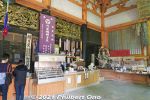
Right corner of Benzaiten-do.
|
|

Another statue of Benzaiten.
|
|
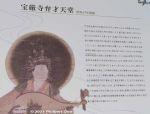
About Benzaiten-do Hall.
|
|
|
|
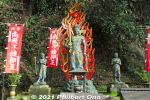
In front of Benzaiten-do is Fudō Myōō 不動明王
|
|
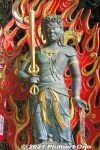
Fudō Myōō (Acala) on Chikubushima. 不動明王
|
|
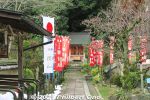
Sanryudo Shrine right next to Benzaiten-do. Worships the dragon god or the god of water. 三龍堂
|
|
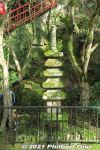
Five-story Stone Pagoda 五重石塔. Important Cultural Property
|
|
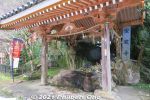
Wash basin
|
|
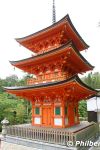
Three-Story Pagoda. Reconstructed in 2000. The original pagoda was destroyed by fire caused by lightning during the early Edo Period. It took six years to complete.
|
|
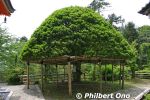
Mochinoko Tree もちの木
|
|
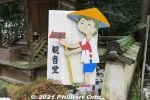
From Benten-do, way to Kannon-do (down the steps).
|
|
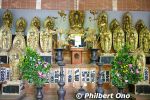
Hall of 33 Kannon Statues. 三十三所奉安所
|
|
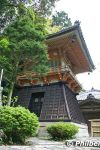
Bell tower
|
|
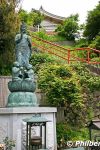
Kannon statue on Chikubushima.
|
|
|
|
|
|
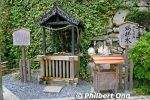
Zuisho-sui Well 瑞祥水
|
|
|
|

Heading for Chikubushima.
|
|

Approaching Chikubushima.
|
|
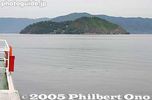
Chikubushima
|
|

Chikubushima used to be a lush green island. Now it is turning brown by the thousands of cormorants which nest on the island, beyond the reach of humans.
|
|

Chikubushima is home to Hogonji Temple first built in 724 as ordered by the Emperor to worship the Goddess Benzaiten. It belongs to the Shingon Buddhist Sect (Buzan School) and it is the 30th temple in the 33-Temple Pilgrimage of Saigoku. 宝厳寺
|
|

Chikubushima is also home to Tsukubusuma (Chikubushima) Shrine which is also a National Treasure. Until 1868 when Buddhist temples and Shinto shrines were required to be separate, the shrine was part of Hogonji temple.
|
|

Whenever you see a torii gate, it indicates the grounds of Tsukubusuma Shrine. The shrine is actually integrated with Hogonji temple.
|
|

Boat landing 宝厳寺
|
|

The name of the boat moored at Chikubushima is "Benten."
|
|
|
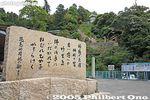
Lake Biwa Rowing Song (Biwako Shuko no Uta) monument. One of the verses mentions Chikubushima. This monument commemorates the song and that verse. 琵琶湖就航の歌 歌碑
|
|
|
|
|
|
|
|
|
|

Torii gate and bridge to Tsukubusuma Shrine, also called Chikubushima Shrine.
|
|
|

Small shrine for the White Snake God, a messenger of goddess Benzaiten. 白巳大神
|
|
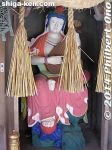
Statue of the goddess Benzaiten at Hogonji, Chikubushima. Benzaiten is the goddess of everything that flows: Water, rivers, music, etc. 弁才天
|
|

Tsukubusuma Shrine's Haiden Hall
|
|
|
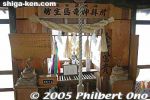
Altar for the Chikubushima Dragon God.
|
|

The snake is a messenger of the Goddess Benzaiten.
|
|

Throw your two dishes at the torii gate. If your dish goes under the torii gate, your wish will come true. Geez, look at all those failed wishes (shattered dishes).This is also one location where the film Idai Naru, Shurararabon (偉大なる、しゅららぼん The Great Shu Ra Ra Boom) was filmed. The scene where Ryosuke throws his small dish through the torii.
|
|
|

View of Nagahama from Chikubushima
|
|
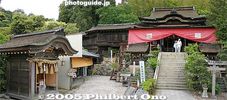
Tsukubusuma Shrine (National Treasure) on Chikubushima island, Nagahama, Shiga. It worships Benzaiten as well as the Dragon God and Azai-hime. 都久夫須麻神社
|
|

Tsukubusuma Shrine (National Treasure)
|
|

Tsukubusuma Shrine (National Treasure)
|
|

Funa-roka boat corridor connects Tsukubusuma Shrine and the Kannon-do Hall. Important Cultural Property. From the Momoyama Period. 船廊下
|
|

Funa-roka boat corridor
|
|

Funa-roka boat corridor
|
|
|

Kannondo Temple
|
|
|

Kannondo Temple 観音堂
|
|

Kannondo Temple
|
|

Kannondo Temple
|
|

Kannondo Temple
|
|

Kannondo Temple
|
|

Very old and worn statue of Pindola Bharadvaja (賓頭盧尊者) inide Karamon Gate.
|
|

Very old and worn statue of Pindola Bharadvaja (賓頭盧尊者) inide Karamon Gate.
|
|

Very old and worn statue of Pindola Bharadvaja (賓頭盧尊者) inide Karamon Gate.
|
|
|

Chikubushima Port.
|
|
|
|
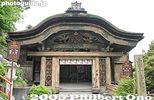
Karamon Gate 唐門 (National Treasure). Entrance to the Kannondo Temple. It might have come from Toyotomi Hideyoshi's original mausoleum in Kyoto. From the Momoyama Period. Chikubushima, Nagahama, Shiga.This could also have been the gate to the Gokuraku Bridge at Hideyoshi's Osaka Castle in the early 17th century.
|
|

Kannondo Temple and Karamon gate of Hogonji temple on Chikubushima island, Nagahama, Shiga.
|
|
|

Benzaiten-do Hall, the main worship hall of Hogonji temple.
|
|

Inside Benzai Tendo.
|
|

Inside Benzaiten-do Hall which houses one of Japan's three major statues of the Goddess Benzaiten.
|
|

Inside Benzai Tendo
|
|

Inside Benzai Tendo
|
|

Inside Benzai Tendo. The statue of Benzaiten in that corner was donated by the father of Lord Azai Nagamasa.
|
|

Inside Benzai Tendo
|
|

Benzai Tendo
|
|

Three-Story Pagoda. Reconstructed in 2000.
|
|
|
|
|
|
|

Chikubushima has some steep steps.
|
|
|
|
|
|
|

Interlaken boat to Imazu at Chikubushima.
|
|

Chikubushima
|
|
|
|

West view of Chikubushima
|
|
|
|
|
|